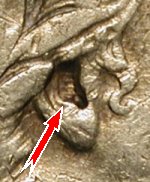|
Authenticating the 1896-S Barber Quarter
| |
| |
|
Diagnostics of genuine coins |
 |
There were only two pairs of dies used to make this date, and they have specific date and mintmark positions.
The date and mintmark of any 1896-S quarter must exactly match one of the following two sets of photos.
Note the squared,
boxy shape of the "S" -- in 1898 it was replaced by a more rounded "S" and many fake 1896-S Barber Quarters use the wrong
style mintmark.
There are also
some other diagnostics that can be used to detect even the best fakes,
and these characteristics are described below.
This reference uses the
terminology found in The Complete Guide to Barber Quarters, 2nd Edition, by David Lawrence, one of the true Barber series
experts of all time.
|
 | |
In addition, it must be noted that both obverse dies became clashed with the reverse dies, leaving a series of horizontal
lines within Liberty's ear (clashed from the horizontal lines of the shield on the reverse). On both sets of dies, this appears
to have occurred early in the production run, as the majority of 1896-S Barber Quarters have them, perhaps as much as 75-80%.
This seems to be unique with
the San Francisco mint, as there are no known examples of 1896-P or 1896-O with these clash marks. While one cannot dismiss
an 1896-S quarter that does not have
these marks (as they didn't all have them), any 1896-S coin with them is almost certainly genuine, and the clash marks
can be easily seen, even on low-grade coins.
|
Another diagnostic that can be used is the edge reeding. In 1896, the three mints used three different
collars to impart the reeded edge, and the San Francisco Mint used finer edge reeding than either Philadelphia or New Orleans.
As a result, any potential 1896-S quarter that still has the edge reeding present (usually VG or better) can be put side-by-side a P-mint
coin and compared. A genuine 1896-S Barber Quarter should have more edge reeds (less width for each reed) than the P-mint coin. If the reeds
line up, then you have a forgery. | |
 |
The single best reference to Barber Quarters, is The Complete Guide to Barber Quarters, 2nd Edition, by David Lawrence
(1992, DLRC Press, Virginia Beach VA).
The above detailed information and photos
Copyright © 2005 Barber Coin Collectors' Society -- all rights reserved worldwide.
This page may be printed and distributed as long as Copyright notice is included.
|

